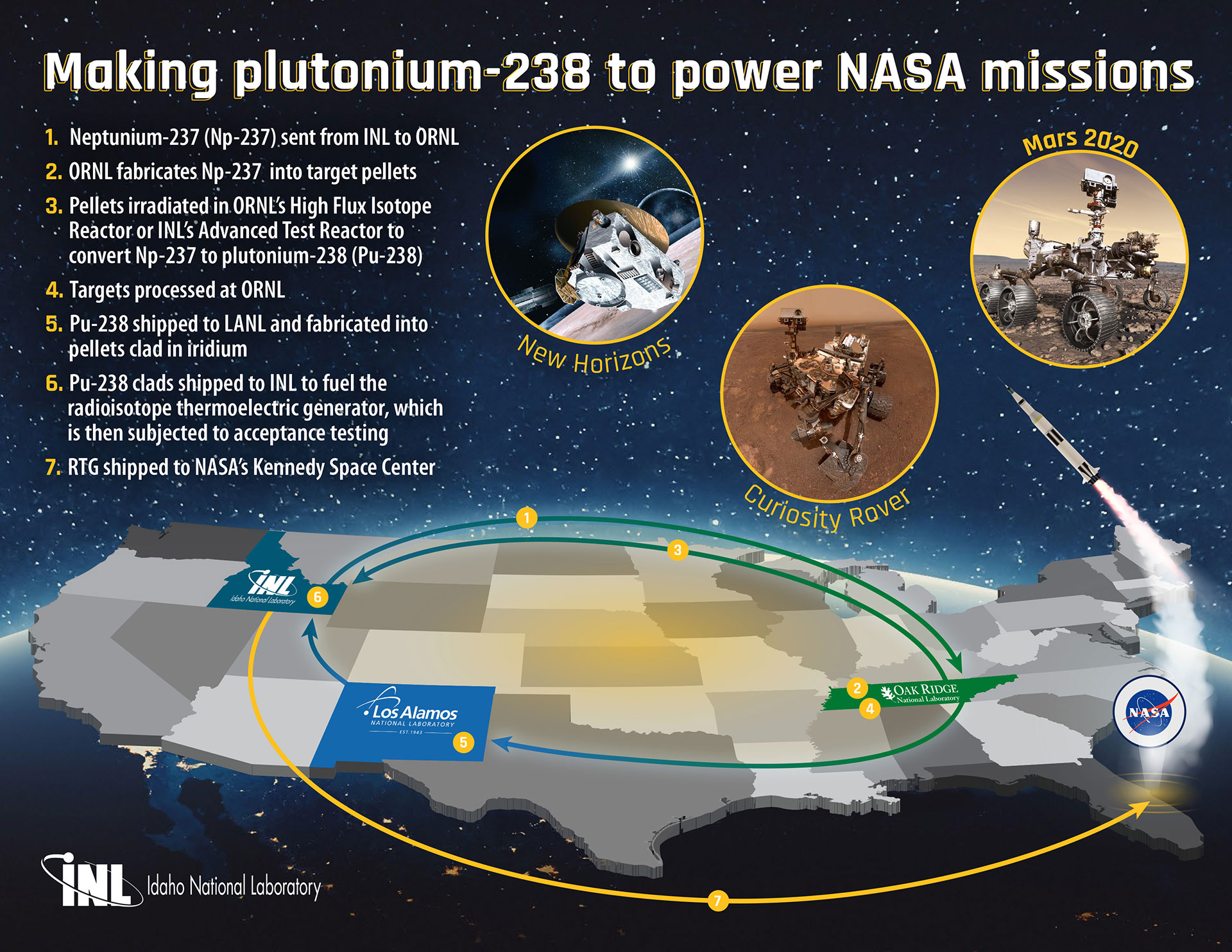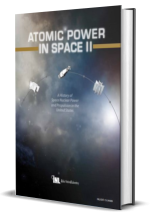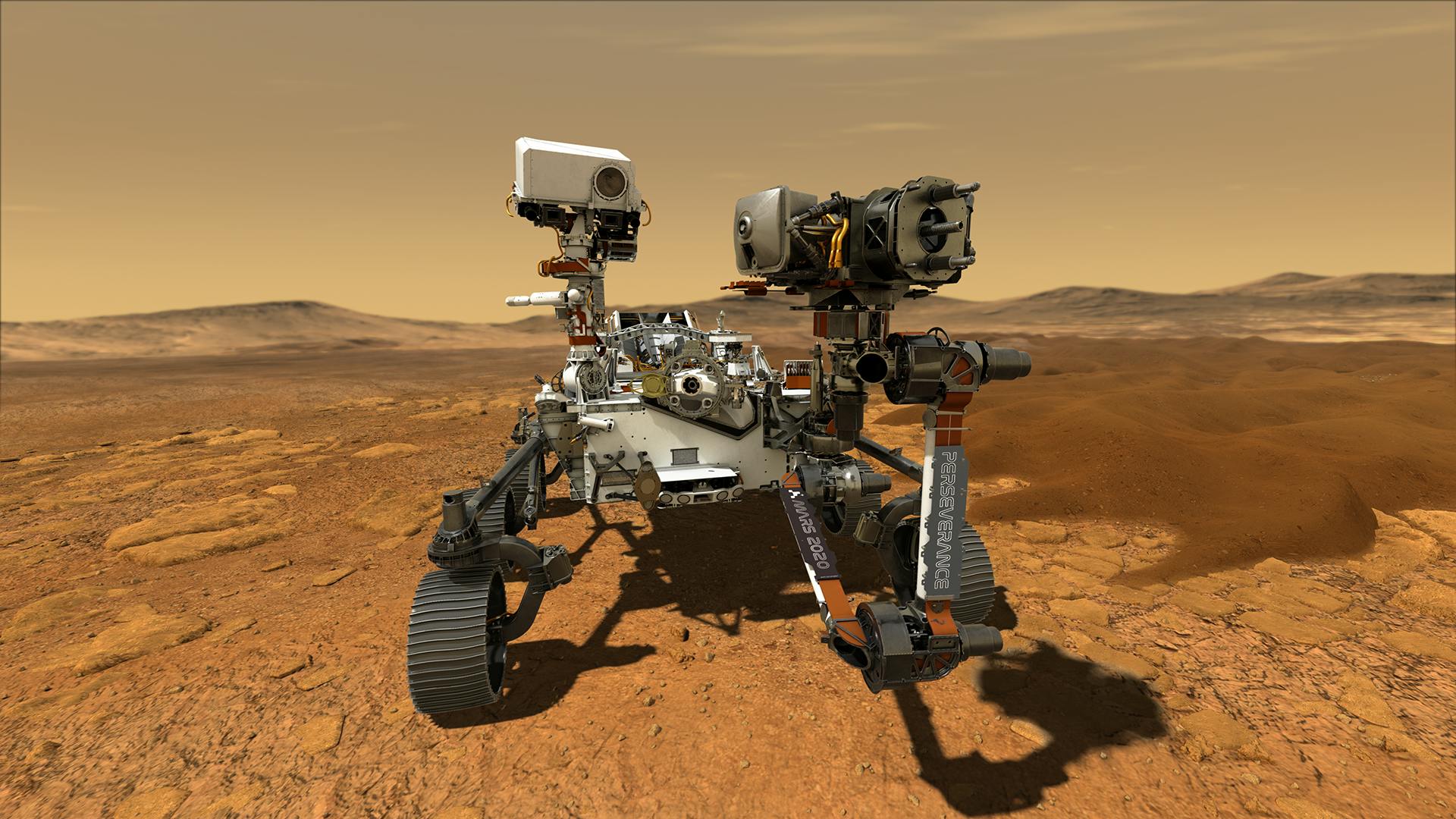
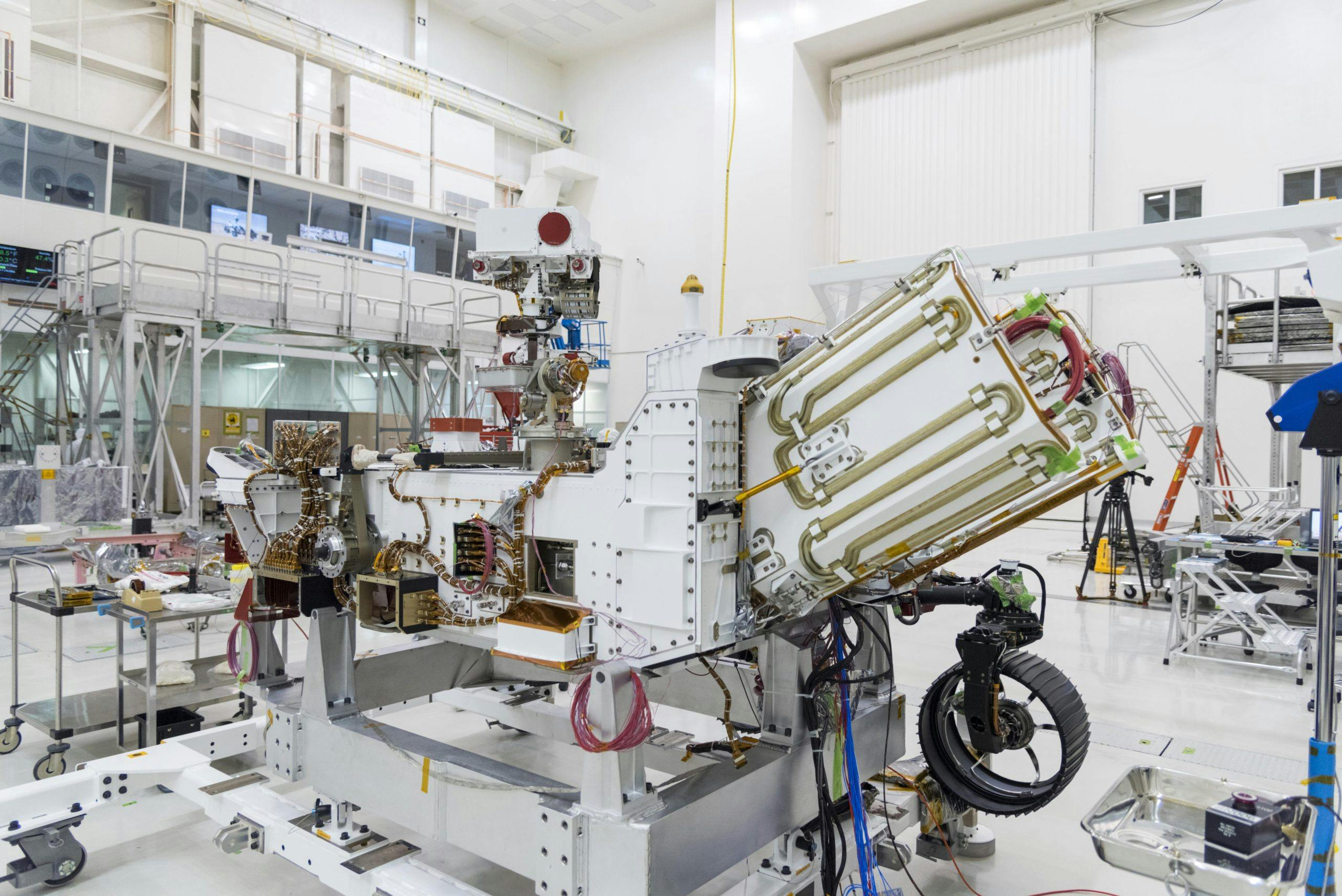
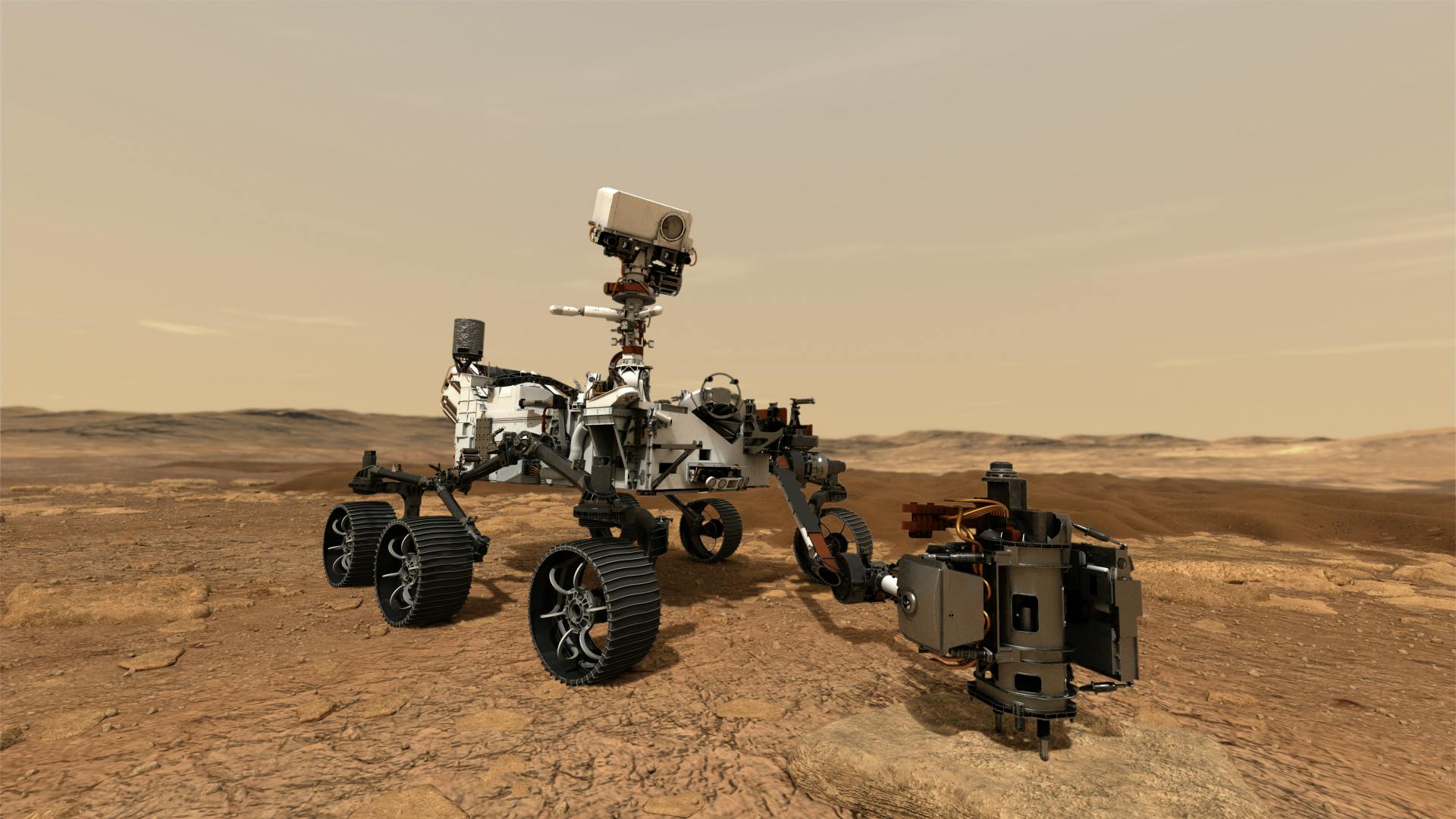
INL Powers Mars Perseverance Rover
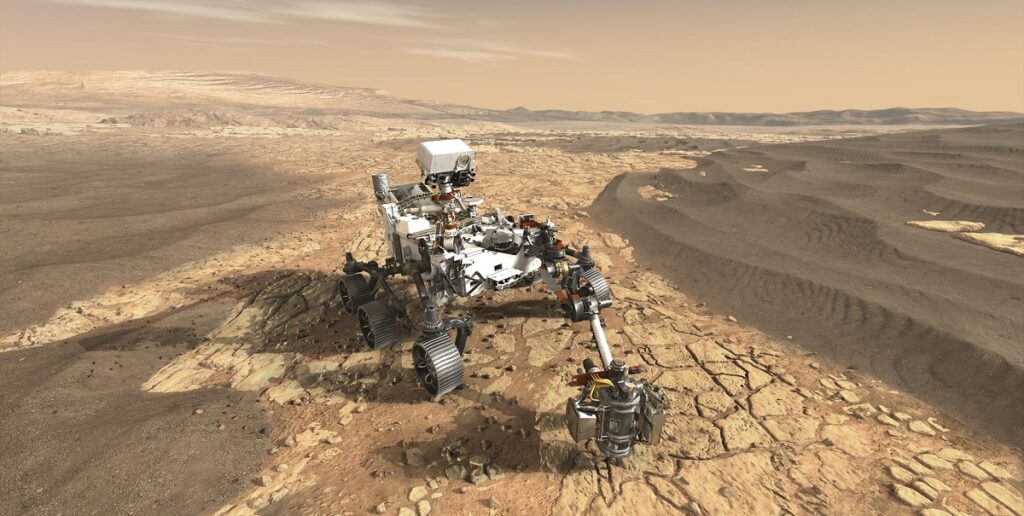
INL recently assembled, tested and delivered to Kennedy Space Center the Multi-Mission Radioisotope Thermoelectric Generator (MMRTG) that will power NASA’s Mars Perseverance Rover.
Powering Perseverance: The Mars Rover has Landed
Following a seven-month journey, Perseverance touched down on Mars at approximately 1:55 p.m. (MST) on Feb. 18. The rover raced through the thin Martian atmosphere heat shield first, slowing its speed. A parachute and then a powered descent navigated the rover to its landing area. When the craft slowed to 2 mph, it was lowered to the surface in Jezero Crater by a sky crane, where it landed on its six wheels. Powered by a nuclear power source assembled, tested and delivered by Idaho National Laboratory, this rover has an exciting expedition ahead!
The Mission
On July 30, 2020, NASA launched their Mars Perseverance Rover.
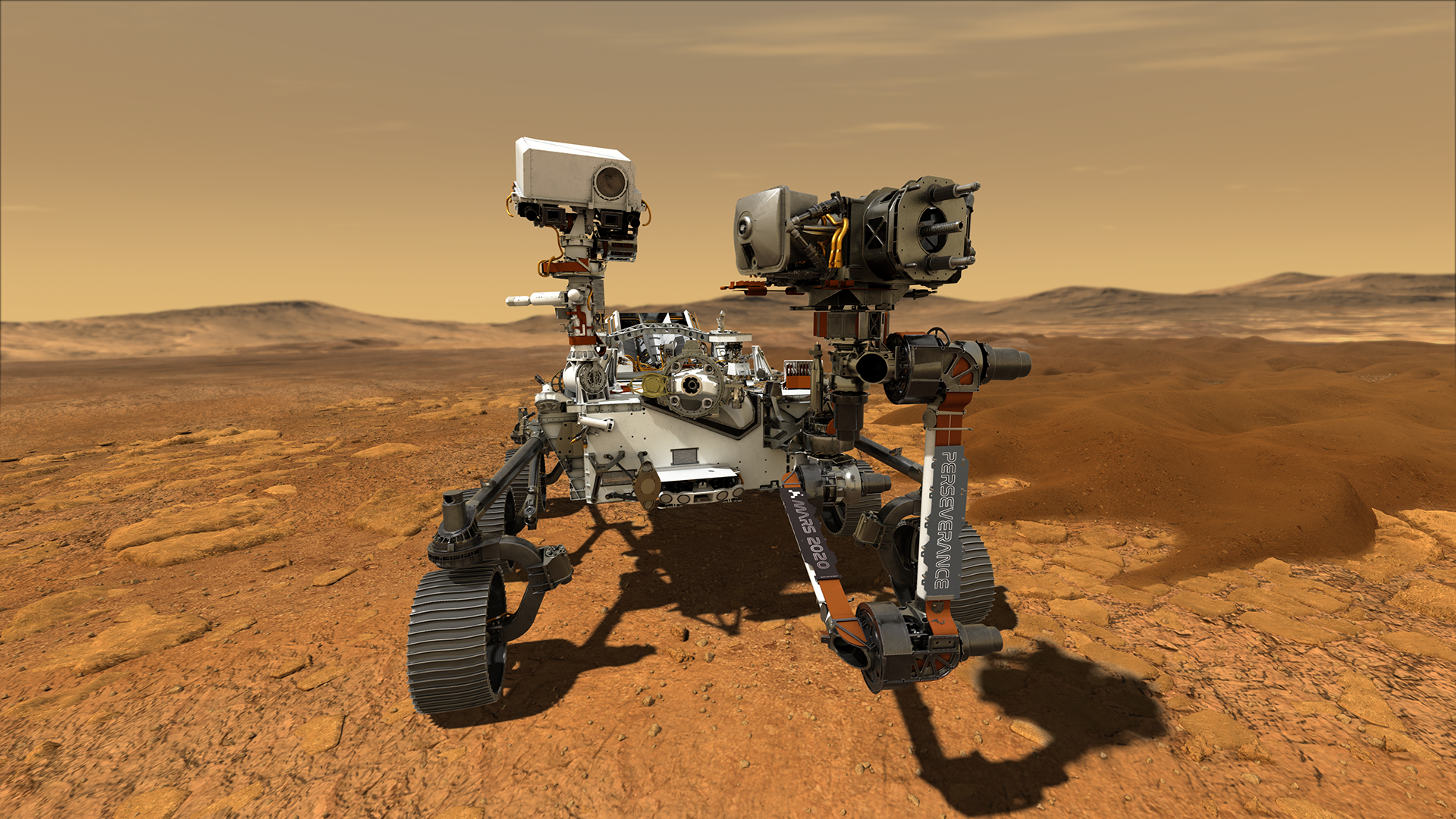
Its mission is simple: To find signs of life and collect rock and soil samples for potential return to Earth in a future mission.
The MMRTG will power Perseverance’s movement and instruments and help keep it warm while exploring the chilly Red Planet. According to NASA, in addition to finding signs of life the mission provides opportunities to learn and demonstrate technologies that address the challenges of future human expeditions to Mars. That includes testing a method for producing oxygen from the Martian atmosphere, identifying other resources (such as subsurface water), improving landing techniques, and characterizing weather, dust, and other environmental conditions that could affect future astronauts living and working on Mars. Perseverance was named following a nationwide “Name the Rover” contest, which received 28,000 entries from students in kindergarten through 12th grade. Alex Mather of Virginia submitted the winning name.
What is INL's Role with Space Travel?
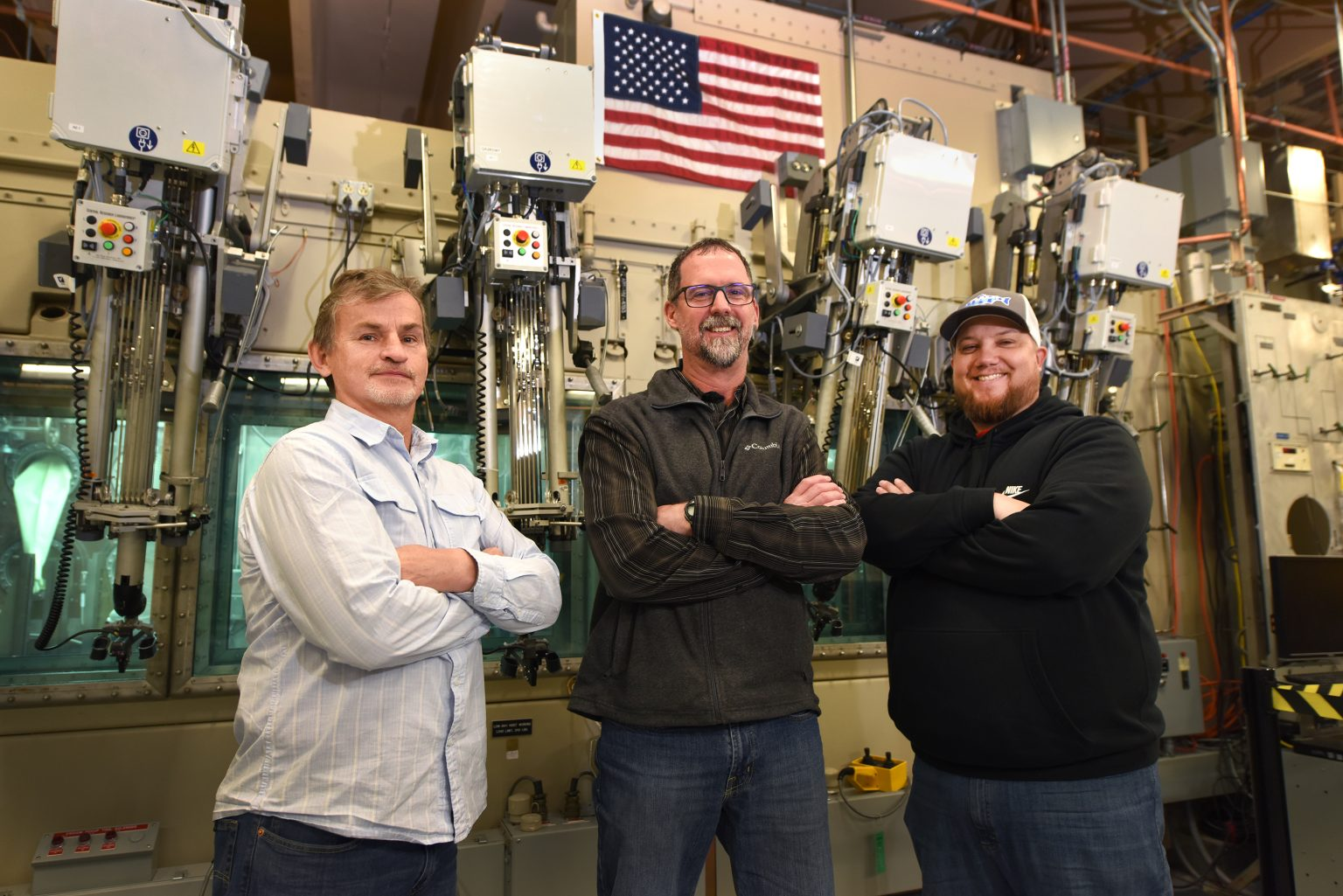
Idaho National Laboratory’s Space Nuclear Power and Isotope Technologies Division assembles and tests Radioisotope Power Systems at Idaho National Laboratory’s Materials and Fuels Complex, then delivers the systems for use in remote, harsh environments such as space.
Generators fueled and tested at INL are currently powering the Mars Science Laboratory Curiosity rover (launched in 2011), the Pluto New Horizons (launched in 2006) and most recently, the Perseverance Rover (launched in 2020) which successfully landed on Mars in 2021.
The next MMRTG will power the Dragonfly rotorcraft lander mission to explore Saturn’s largest moon, Titan. Dragonfly is scheduled to launch in 2026. INL would fuel and test that power source.
And there’s more ahead for INL’s Space Nuclear Power and Isotope Technologies Division (SNPIT), which is getting more involved in space reactors for both nuclear thermal propulsion and fission surface power applications.
National Labs Fuel Space Exploration
Perseverance will be the first rover to use plutonium created by Oak Ridge National Laboratory. The lab, along with Idaho and Los Alamos national laboratories, is helping NASA beef up its fuel supply for plutonium-238 — an isotope used for deep space missions.
While the United States has enough plutonium to fuel the space missions scheduled for the next decade, the domestic supply of plutonium is a limited resource. In order to establish a new supply of Pu-238 to enable future NASA missions, Congress directed the Department of Energy to resume Pu-238 production.
The steps to produce new Pu-238 require many facilities and unique processing capabilities. INL’s Advanced Test Reactor is one of two sites (Oak Ridge’s High Flux Isotope Reactor is the other) where neptunium is converted to Pu-238. INL also assembles, tests, and delivers the power source to NASA.
What is an MMRTG and How Does it Work?
Multi-Mission Radioisotope Thermoelectric Generators are ideal for space missions because they are compact, durable and reliable, providing continuous power over long periods of time. The Department of Energy provides radioisotope power systems to NASA for civil space applications. The MMRTG for the Mars 2020 mission was fueled and tested at the DOE’s Idaho National Laboratory. This spring it was shipped directly from INL to the launch site at Kennedy Space Center Florida for integration into the rover.
MMRTGs work by converting heat from the natural decay of radioisotope materials into electricity. The generators consist of two major elements: a heat source that contains plutonium-238 (Pu-238) and thermocouples that convert the plutonium’s decay heat energy and the cold of space to electricity. The MMRTG is designed to produce about 110 watts of electrical power to begin the mission. The system has a design life of 17 years, but can be expected to produce power much longer than that. Additionally, the MMRTG provides a source of heat for the rover’s instruments and on-board systems in the cold environment. Thermocouples have no moving parts and have proved an amazingly reliable source of energy for space missions.
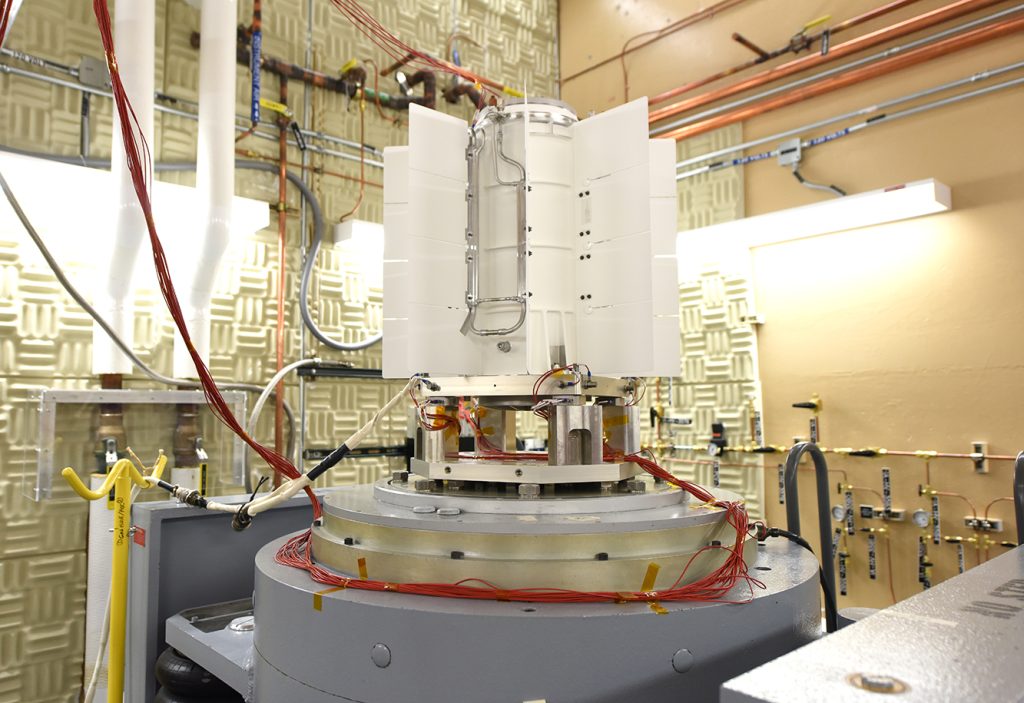
Timeline
This timeline provides information on each milestone for the Mars 2020 Multi-Mission Radioisotope Thermoelectric Generator.
Scroll through the timeline events below.
Hot Topics
National labs resume plutonium production for space exploration
While the United States has enough plutonium to fuel the space missions scheduled for the next decade, the domestic supply of plutonium is a limited resource. In order to establish a new supply of Pu-238 to enable future NASA missions, Congress directed the Department of Energy (DOE) to resume Pu-238 production.
To Pluto and beyond: Work that reaches the stars
They’ve stayed in the same spot for more than a decade, but their work has traveled to Pluto and beyond, and landed on the surface of Mars.
Bob Gomez, Courtney Swassing and Jon Bradley have spent most of their Idaho National Laboratory (INL) careers in the Space and Security Power Systems group, which assembles and tests Radioisotope Power Systems such as Multi-Mission Radioisotope Thermoelectric Generators (MMRTG) and other Radioisotope Thermoelectric Generators (RTGs) for use in remote and harsh environments, principally space.
Spuds and Space: NASA and Idaho have a long history
When people think of NASA, Idaho doesn’t exactly jump to mind.
Cape Canaveral and the Kennedy Space Center are in Florida. Johnson Space Center and Mission Control are in Texas. And the Jet Propulsion Laboratory is in California.
But Idaho’s contributions to space exploration date back to the early years of the space race and continue today.
Prepping the Perseverance Power Source
Atomic Power in Space II
A HISTORY OF SPACE NUCLEAR POWER AND PROPULSION IN THE UNITED STATES
Atomic Power in Space II is a sequel to Atomic Power in Space (published by the Department of Energy [DOE] in 1987). Beginning with a brief overview of the programs and systems developed through the late 1970s, Atomic Power in Space II traces the development and use of space nuclear power systems, including the missions and programs for which they were developed, to the present day. The history is written largely in nontechnical language so as to be useful to the general reader as well as the seasoned space nuclear professional.
STEM Activity Book
Check out this STEM activity book to keep you and your kids busy while learning from home.
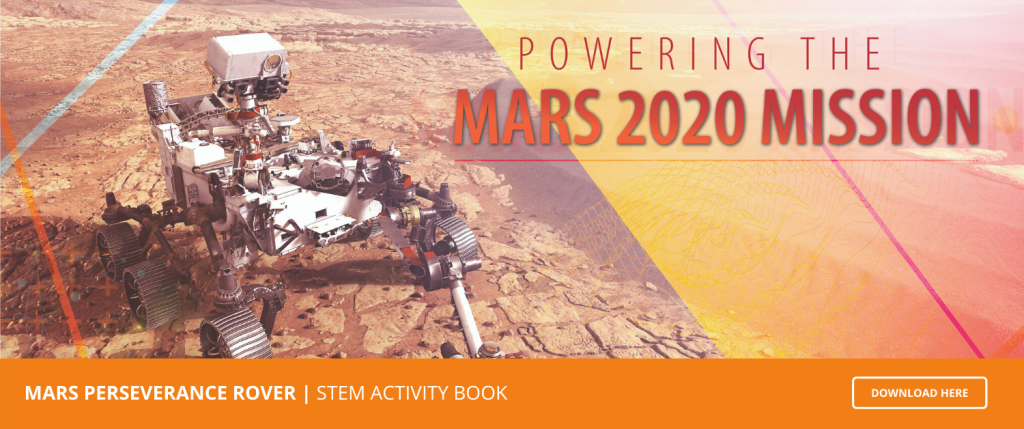
Questions? Email Jeff Pinkham or call (208)-533-7404
Image Gallery
Frequently Asked Questions
What is Plutonium-238?
Plutonium-238 (Pu-238) is an isotope of plutonium, a radioactive metal that is formed when neptunium-237 captures neutrons and undergoes beta decay. While trace amounts of plutonium may occur naturally in uranium deposits, it is mostly made as a byproduct of nuclear fission within a nuclear reactor.
The Pu-238 isotope has a half-life (the amount of time it takes for the radioactivity of an isotope to fall to half of its original level) of 87.7 years and gives off a significant amount of heat.
What is Pu-238 used for?
RTGs work by converting thermal energy into electrical energy through devices known as thermocouples. The natural decay of plutonium-238 produces heat that is then transferred to one side of the thermocouple. The temperature difference between the fuel and the atmosphere allows the device to convert this heat into electricity. The most current RTG model, the Multi-Mission Radioisotope Thermoelectric Generator (MMRTG), provides approximately 110 Watts of electrical power when freshly fueled.
RTGs are built to last. Its sturdy and compact design make it an ideal energy source for remote operations. They can withstand the harsh environments and frigid temperatures of deep space travel for decades, have no moving parts and require no maintenance, and have proven to be extremely reliable. In fact, some RTGs launched decades ago, are still in operation today like the Voyager mission that first started in 1977.
Why does NASA need more Pu-238?
High-purity supplies of Pu-238 are scarce, due in part to older stockpiles of Pu-238 having undergone radioactive decay. The last time the U.S. produced material was in 1988. Starting in 1990, the U.S. bought supplies from Russia, but sales stopped in 2009. The U.S. reestablished production in 2015.
How is Pu-238 made?
Pu-238 is produced through nuclear reactions in a nuclear reactor. The fuel within reactors gives off neutrons during the fission process. “Target” material is fabricated, placed in a reactor where it can be irradiated to absorb neutrons and be transmuted to another material.
What is INL’s role?
The next generation of RPS have opened the door to a host of new opportunities. MMRTGs have even more flexible designs that allow them to operate through the vacuum of space and planetary atmospheres. NASA will use a MMRTG in its upcoming Mars 2020 rover mission and a MMRTG for the Dragonfly rotorcraft lander mission to explore Titan in 2026.
Learn more about DOE’s role in helping power U.S. space missions.
Who is funding the production of Pu-238?
NASA
What happens if a rocket carrying Pu-238 has a problem on takeoff?
Plutonium-238 is encapsulated in multiple protective layers designed to withstand heat and to prevent the spread of Pu-238 in the event of an accident. The Pu-238 oxide pellet itself is designed with chemical and mechanical properties to reduce accident consequences.
What is a radioisotope power system?
Radioisotope Power Systems (RPS) convert heat generated by the natural decay of plutonium-238—a radioactive isotope—into electrical power. They have powered more than two dozen U.S. space missions and are capable of producing heat and electricity under the harsh conditions in deep space for decades without any maintenance.
Types of Radioisotope Systems
There are two types of radioisotope power systems:
- Radioisotope Heater Units (RHU): Small devices that provide heat to keep a spacecraft’s electronic instruments and mechanical systems operational in the cold temperatures of our solar system.
- Radioisotope Thermoelectric Generator (RTG): Flight-proven systems that provide power and heat to a spacecraft.
How does an RTG work?
RTGs work by converting thermal energy into electrical energy through devices known as thermocouples. The natural decay of plutonium-238 produces heat that is then transferred to one side of the thermocouple. The temperature difference between the fuel and the atmosphere allows the device to convert this heat into electricity. The most current RTG model, the Multi-Mission Radioisotope Thermoelectric Generator (MMRTG), provides approximately 110 Watts of electrical power when freshly fueled.
RTGs are built to last. Its sturdy and compact design make it an ideal energy source for remote operations. They can withstand the harsh environments and frigid temperatures of deep space travel for decades, have no moving parts and require no maintenance, and have proven to be extremely reliable. In fact, some RTGs launched decades ago, are still in operation today like the Voyager mission that first started in 1977.
Developing RTGs
The U.S. Department of Energy (DOE) develops RPS for NASA by utilizing the specialized facilities at its national labs.
Oak Ridge National Laboratory provides the heat source materials and hardware. Los Alamos National Laboratory purifies and encapsulates the plutonium-238. Idaho National Laboratory then assembles, tests, and assures the final delivery of the RPS.
History of RTGs
First generation RTGs carried small amounts of radioisotope materials and were built to burn up at high altitudes during an accidental reentry. That’s changed with later designs which contain the plutonium in case of reentry. RTGs hold an excellent performance record and have never been the cause of a spacecraft accident. Of the 3 failed missions with RTGs on board, the power systems performed as designed.
For more than 50 years, DOE and its predecessor, the Atomic Energy Commission, has successfully provided RPS for NASA, Navy and Air Force missions. RTGs have contributed to many monumental and historic space missions such as the Apollo missions to the moon, the Viking and Curiosity missions to Mars, the New Horizons mission to Pluto and the Kuiper Belt and the Cassini mission to Saturn.
What’s next?
The next generation of RPS have opened the door to a host of new opportunities. MMRTGs have even more flexible designs that allow them to operate through the vacuum of space and planetary atmospheres. NASA will use a MMRTG in its upcoming Mars 2020 rover mission and a MMRTG for the Dragonfly rotorcraft lander mission to explore Titan in 2026.
Learn more about DOE’s role in helping power U.S. space missions.

